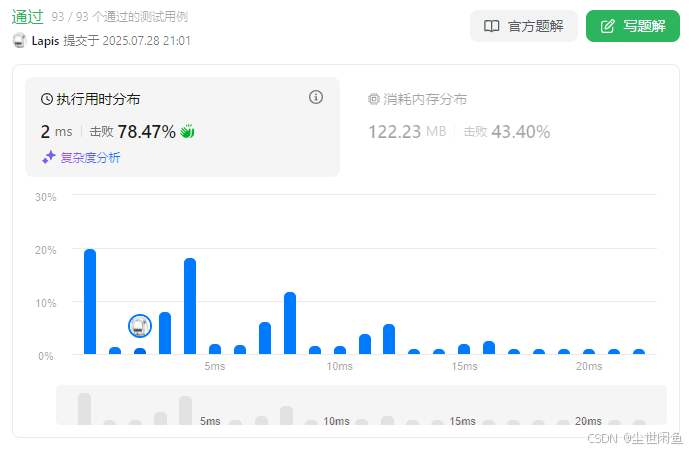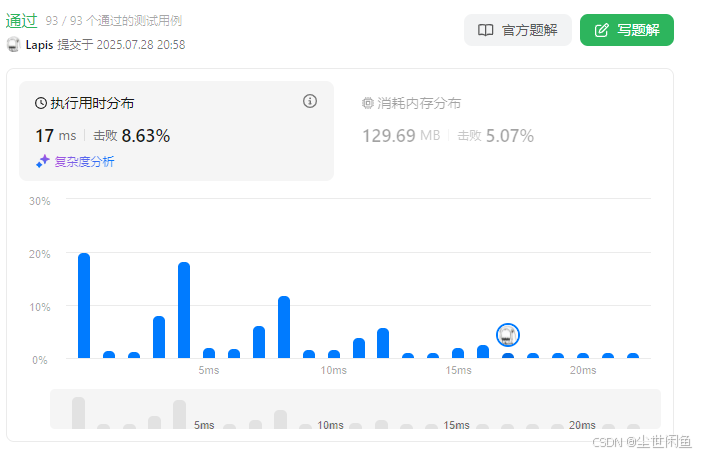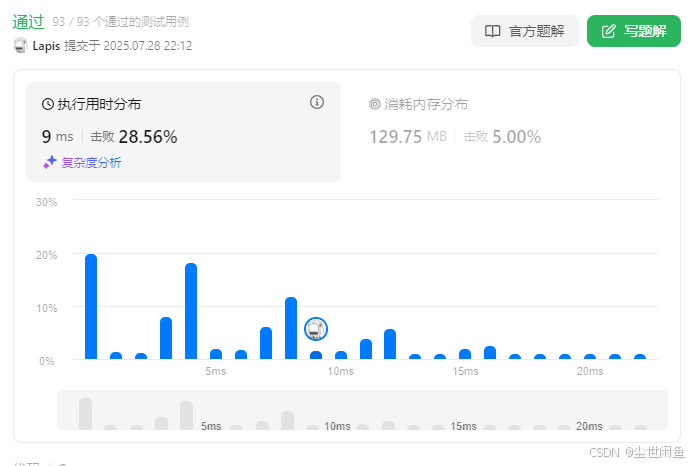给你一个单链表的头节点 head ,请你判断该链表是否为回文链表。如果是,返回 true ;否则,返回 false 。
示例 1:
输入:head = [1,2,2,1]
输出:true
示例 2:
输入:head = [1,2]
输出:false
LeetCode链接:https://leetcode.cn/problems/palindrome-linked-list
思路一、使用数组辅助存储
链表的难点在于无法获取前一个元素,因此可以考虑将前半部分的元素使用数组进行存储,然后逆序和链表进行比较。基于以上思路,可以得到以下代码:
class Solution {
public:
bool isPalindrome(ListNode* head) {
int length = 0;
ListNode* tmp = head;
while(tmp){
length++;
tmp = tmp->next;
}
vector<int> halfList(length / 2);
tmp = head;
for (int i = 0; i < length / 2; i++) {
halfList[i] = head->val;
head = head->next;
}
if(1 == length%2){
head = head->next;
}
for (int i = (length + 1) / 2; i < length; i++) {
if (head->val != halfList[length - i -1])
return false;
head = head->next;
}
return true;
}
};
执行结果:

思路二、使用栈和递归
回文链表最重要的是判断两端是否相等,一段在头,一段在尾,这种方式完美适配队列和栈,因此可以将元素值分别压入队列和栈,然后进行判断。根据以上思路可以得到以下代码:
class Solution {
public:
bool isPalindrome(ListNode* head) {
stack<int> valStack;
queue<int> valQueue;
while (head) {
valStack.push(head->val);
valQueue.push(head->val);
head = head->next;
}
while (!valStack.empty()) {
if (valQueue.front() != valStack.top())
return false;
valQueue.pop();
valStack.pop();
}
return true;
}
};
执行结果:

关于代码执行时间的思考
两种算法都是O(n)级别的时间复杂度,执行时间应该相仿,但是可以明显看出,使用队列和栈的方法明显慢于使用列表的方法,这可能是因为队列和栈中有大量的出入栈、出入队列操作,而且列表中使用了提前结束,但是队列和栈中则是进行了全部遍历。为此,在队列中加入长度计数器,提前终止减少出队列、出栈的操作次数。得到了以下改进后的思路二代码:
class Solution {
public:
bool isPalindrome(ListNode* head) {
int length = 0;
stack<int> valStack;
queue<int> valQueue;
while (head) {
valStack.push(head->val);
valQueue.push(head->val);
head = head->next;
length++;
}
//改为使用长度进行判断
for (int i = 0; i < length / 2; i++) {
if (valQueue.front() != valStack.top())
return false;
valQueue.pop();
valStack.pop();
}
return true;
}
};
执行结果:

可以看到,降低了近一半的执行用时,但和列表相比还是耗费了大量用时。